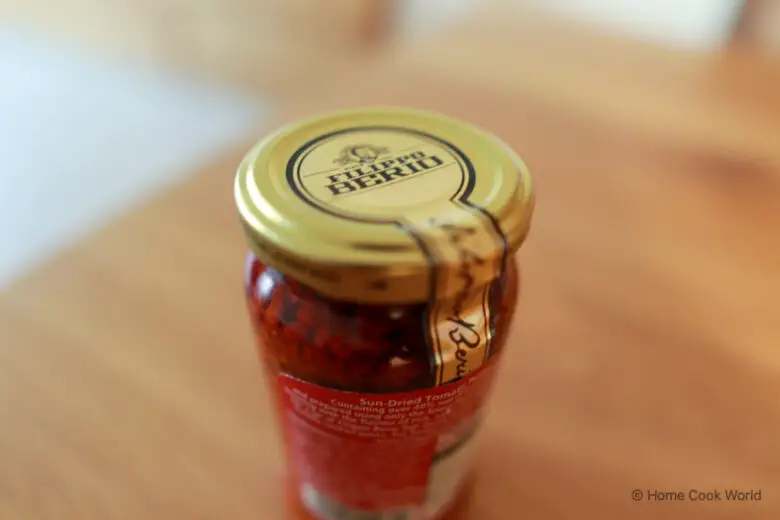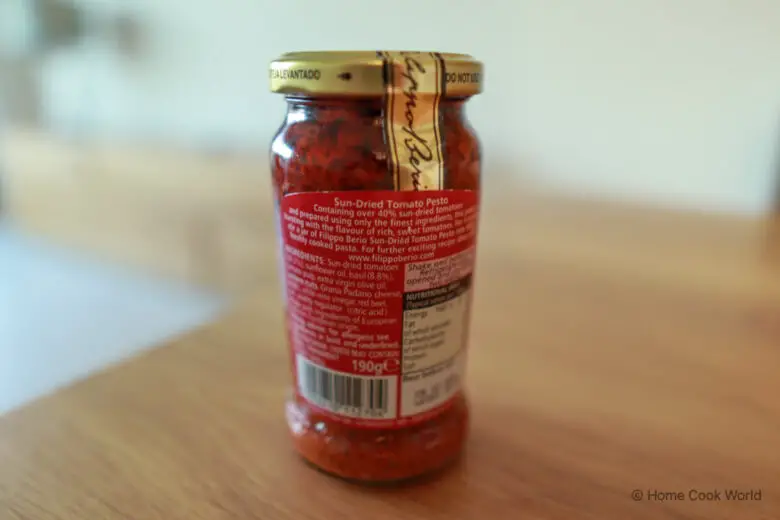I recently found a jar of Filippo Berio Sun-Dried Tomato Pesto at my local grocery store, and I was excited to try it. After cooking egg tagliatelle in a pot of generously salted water and saucing them with it that night, I tasted the pasta dish.
Here’s how I found it (along with a few other things you need to know about this jarred red pesto sauce).
The first bite had a nutty and savory flavor from the cashews and Grana Padano cheese, made from cow’s milk and typically aged for a minimum of 9 months. The sun-dried tomatoes complemented it with a sweet, slightly acidic tone.
I had high expectations for the texture, and this sauce managed to live up to them. It was creamy without being too oily or runny—coating each strand of the tagliatelle pasta evenly with just enough body.
When you’re craving red pesto pasta but don’t feel like making the sauce from scratch, Filippo Berio Sun-Dried Tomato Pesto is a perfect option for a simple and savory dish that requires close to no effort.
But would I buy it again?
One of the things I do is to read through the ingredients list to come to the answer. I’m looking for a list with few to no additives or preservatives in it, ideally with only natural or minimally modified ingredients.
So let’s see how this one fairs.



Reading Through the Ingredients List
It’s made with sun-dried tomatoes (40.2%), sunflower oil, basil (8.8%), tomato pulp, Filippo Berio Extra Virgin Olive Oil, cashew nuts, Grana Padano cheese, white wine vinegar, red beet, salt, and citric acid.
I can’t say I’m thrilled about this product’s undisclosed amount of sunflower oil. On the one hand, the use of sun-dried tomatoes, which are typically preserved with lesser-grade oil, is probably one of the sources. On the other, Filippo Berio's Green Pesto also contains sunflower oil, so it could be a way to cut costs (extra virgin olive oil, after all, is a much more expensive ingredient).
Unless I dried the tomatoes myself, even homemade red pesto with jarred sun-dried tomatoes from the store would have a trace of sunflower oil in it. So let’s just say the jury’s out on this one.
Let’s make this a discussion, folks! Is the presence of sunflower oil a problem for you at all?
Curious to read your thoughts in the comments below.
Citric acid is a commonly used preservative in food manufacturing. While it can be naturally derived from lemons (and citrus fruit in general), the reality is that most food companies use synthetic citric acid (FDA approved and not known to cause any risks to your health).
Aside from the sunflower oil and citric acid, Filippo Berio Sun-Dried Tomato Pesto's ingredients list is about as clean as it gets on a product of this kind. So, yes, this jar of pesto will not go to waste, and you’ll unquestionably see it on my pantry shelves now and then.
Here are this product’s nutritional facts per 100 grams:
- Energy — 409 calories
- Total fat — 42 grams
- of which saturated fat—4.9 grams
- Carbohydrates — 4.2 grams
- of which sugars—3.2 grams
- Protein — 2.5 grams
- Salt — 2.8 grams
A 6.7 oz jar of red pesto, Filippo Berio says, contains 3 servings of 1/4 U.S. cup (60 grams) each. In other words, one jar should be enough for three meals if you cook for yourself or one dinner if you’re feeding a family of two or three.
Pesto, as you can see, is anything but a weight-loss food. It’s prepared with a high amount of vegetable oil and hard Italian cheese, which is why it packs plenty of calories and a certain amount of cholesterol. Keep it in mind if you need to monitor your daily intake.
Who Makes Filippo Berio Red Pesto?
Long-time readers of Home Cook World know I like to buy my Italian foods from Italian family-owned businesses with a long history. Filippo Berio scores low on criterion no. one and high on no. two here. To show you why, I need to tell you the company’s story first.
The history of Filippo Berio dates back to 1876 in Lucca, a city on the Serchio river in Italy’s Tuscany region. Lucca and its surroundings are known for their olive trees and the bright yellow olive oil from their fruit.
Filippo Berio, a local merchant, started selling olive oil in 1850. 1876 was the year he created his olive oil blend, laying the foundations of the brand that has been known for well over a century. Berio would stamp his signature onto each bottle to assure customers of the quality of his oils.
He passed away in 1894. His daughter, Albertina Berio, inherited the business. In 1919, she founded the company Società per Azioni Lucchese Olii e Vini (Salov S.p.A.) with two business partners, Giovanni Silvestrina and Dino Fontana.
In the early 1900s, Filippo Berio became one of Italy’s most exported brands, and its olive oils won numerous awards at international trade shows. Production was halted during World War II but resumed in the year 1940 and continues to this day.
Today, SALOV continues to make olive oil in its facility in Massarosa, just outside Lucca. But it’s no longer a 100% family-owned business. Today, the majority owner of Salov S.p.A. is the Chinese company ShangHai Yimin No.1 Foods (Group) Co., also known as “Bright Foods.”
In Conclusion
Filippo Berio Sun-Dried Tomato Pesto is a tasty and well-textured red pesto that gave me good value for the money—and I’d buy it again.
It’s bright with sun-dried tomatoes, basil leaves, garlic cloves, and cashew nuts in an extra virgin olive oil base. The flavor profile was bold but not overpowering, a perfect balance of savoriness from the Grana Padano cheese and tangy sweetness from the tomato.
If you gave this product a try, share if you liked it in the comments below!
Check the most recent price at Amazon →
